Worship of Lord Brahma, Part 14
BY: SUN STAFF
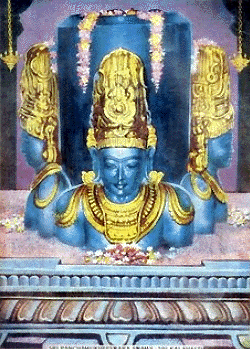
Sri Panchamukheeswara Swamy
Aug 18, CANADA (SUN) — A serial exploration of places of Lord Brahma's worship.
Brahmalingeshwara Manifestations of Brahma and Shiva
Following yesterday's introduction to the Brahmalingeshwara manifestations, in today's segment we look at several examples of Brahma-linga that bring the matter to a finer point. In one case, we have a Brahmalingeshwara temple that is dedicated to Lord Brahma, another temple close by that is associated with the same Brahmadev pastime, but which houses a linga combining Durga Ma and Trimurti, and a third Brahmalingeshwara temple that is actually dedicated to Lord Shiva.
One aspect of the inconceivable nature of these linga manifestations, being a relationship between Lord Brahma and Lord Shiva, is described in an interesting description of a pastime wherein the Goddess Saraswati poured her divine Ambrosia into the Brahma Kabhaalam. Lord Shiva, after feeling the heaviness of the bowl, took it near his mouth to drink the contents. The Brahma Kabhaalam then absorbed Shiva into it, and with Shiva's potency, it recreated the ruins that it had digested earlier, animating in each entity minuscules of Shiva. It then simultaneously ejected the entire Universe of life, retaining a major portion of Shiva within itself. It is thus called Sri Lingajeeranamoorthi, meaning the God (Brahma) who digested Shiva, the Lingam.
Saraswathi, who was a witness to this pastime, held the Four-headed Brahma as a tetradent called Soolam, within her grip. She positioned the tetradent in such a way that when Shiva was sucked into the Kabhaalam, and the Universe and Time were ejected, the fifth head of Brahma was able to safely land over the cavity at the centre of the other four heads. In this way, Shiva was permanently contained within the regime of the Pancha-mukha Brahma. In glorification of this feat of restoring her beloved Lord Brahma with his pivotal head, Saraswati acquired the name, Sri Ankaala Parameswari, meaning the Goddess who rules the Limbs.
The Panchamukheeswara Swami linga pictured above is a depiction of Lord Brahma in his Brahmalingeshwara form, which comprises an element of Lord Shiva, as described in the Kabhaalam pastime. This relationship between Brahma and Shiva in the linga form is yet another cause for the worship of Brahmadev as lingam - a form which is typically a manifestation of Lord Shiva.
Brahmalingeshwara Temple at Maranakatte
Another Brahmalingeshwara temple that is dedicated to the worship of Lord Brahma is found at Maranakatte, a village located in Kanchinakodlu, 16 km from Kundapura district, Karnataka. Kundapura is in the area of Udayavani, which is along the Udupi coast.
The Maranakatte Brahmalingeshwara temple sits to the right of a river which flows in the north-south direction, but takes a sharp turn towards the east. This configuration of the water is said to be very auspicious.
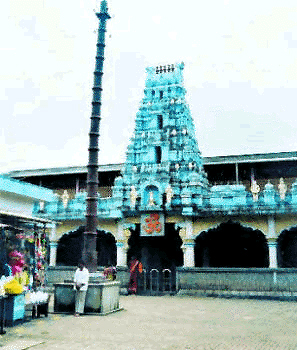
Brahmalingeshwara Temple, Maranakatte
As usual, the Brahmalingeshwara Temple faces east, while the Sanctorum faces north. Lord Brahma in his Brahmalingeshwara form is the presiding Deity. On either side of him are Malyali Yakshi and Vata Yakshi, along with two dwarapalakas (temple guards). In front of the Sanctorum there is a Buvaneshwari Yanthra. Beside the Brahmalingeshwar gudi (altar) there is a daivadha mane (shrine) of Haiguli and Chikku (two bhutas).
Mention of this place is made in the Bhairava Purana, Sri Maranakatte Brahmacaritra. In 36 verses, it describes the demon Muka, slain by Devi, who was reborn as Maranakatte Brahma, in her service. The image below is of that Maranakatte Brahma, flanked by the Yakshi's. The relationship to the demon Muka is seen in the fearsome facial features and sword, not typically associated with Lord Brahma.
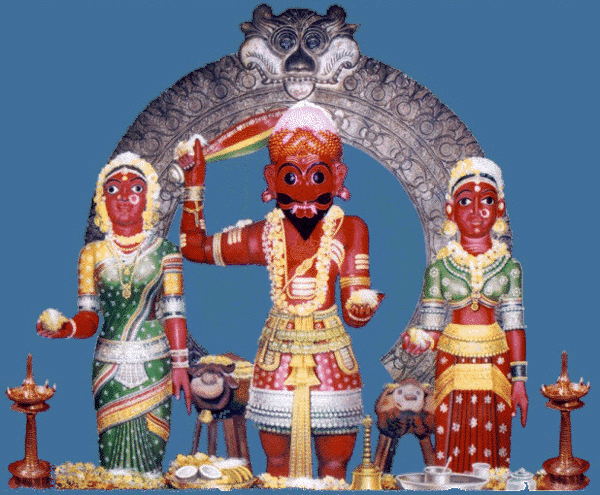
Maranakatte Brahma
The Maranakatte Brahmalingeshwara Temple is closely associated with Adi Shankaracharya, who visited many sites in this area, and was responsible for various installations.
On Makara sankranthi, the temple hosts a festival which attracts thousands of devotees from all over the district. Getting darshan here on that day is said to enable the settling of disputes and the cementing of promises uttered in the name of God.
Mookambika Brahmalingeshwara
In nearby Kollur, which is 80 km. from Udupi, the Mookambika temple is located. This is where the Goddess Mookambika performed a Marana Homa yajna after killing the demon Mookasura (Mahishasura).
Pilgrims traveling to Kollur in Udupi district to visit the famous Mookambika temple always make a stop at Maranakatte, because the entire region is associated with Mookambika's killing of the demon Mookasura with Sri Chakra. The name 'Maranakatte' literally means, 'the altar of death'.
The worship of Shri Yakshi and Shri Brihalingeswara Devaru goes on at both temples. At Mookambika, there is a Sri Chakra Yantra that was installed by Adi Shankaracarya.
In descriptions of how Durga Ma came to be known as Mookambika and how she incarnated in this place, we read that Lord Shiva created a Sri Chakra here, and the geography itself is in the form of a chakra. In Kolhapura, Mahalakshmi is in the Shakti form and in Kolpuri, she is in Vishnu's form, known as Vaishnavi.
The Sage Kola, a Brahma-maanasa-putra (son born from the mind of Brahma) did penance here for vanquishing of demon Kolasura. While deep in meditation, he had darshan of Lord Visnu and Shiva. Lord Brahma also came with all the Devatas. This led to the pastime of Durga's slaying Mahishasura.
Visnu, Brahma and Shiva came together and discussed how to vanquish Mahishasura. They made a sankalpa together, thus emanating Tejas/shakti from the face of the Trimurti, and the faces of other Devatas. All these joined together in the most powerful form of Chandi, the form of Durga Ma who killed Mahishasura.
Hearing all of these pastimes, it is easy to understand why Lord Brahma is glorified in this place. He is worshipped in the form of Brahma Kunda, which flows to the north of the Mookambika temple. This is a highly favored place for devotees to take sacred bath. But most importantly, he is worshipped here as Swayambhulinga, the presiding Deity of Mookambika Temple.
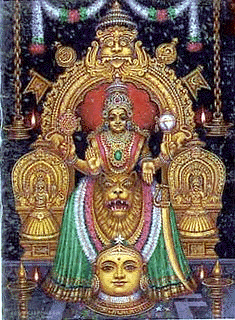
Swayambhulinga
Sri Swayambhulinga manifested itself when Shiva Parameshwara drew the Sri Chakra with his toe, and Kola Maharshi performed his long penance here. Udhbhava linga is the tangible form of Sri Chakra Bindu, said to have the proximity of all the gods. Shri Mookambika Devi merged with this Linga, fulfilling the desires of devotees.
A golden line has formed in the Swayambhu Linga, marking it as wider on the left side, and taller. This portion of the lingam is said to embody the Goddesses Lakshmi, Parvathi and Saraswati, all of whom have merged in the left side. Lord Parameshwara, Lord Vishnu and Lord Brahma reside on the right side of the linga.
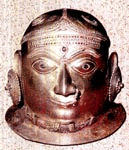
Besides the golden line, on the right side of the linga there is also a carved image of Shiva injured by Arjuna's blow during the clash of Kiratharjuna. Towards the left is an image of Gopada, foot of the Mother Cow at the Shakthi Peeta.
Adi Shankaracharya is said to have perceived and realized Goddess Mookambika as residing thus. He appeared at this place, wishing to find a place for enshrining Sri Saraswati. He stopped at this temple, fixed Sri Chakra, and installed the Deity of Mookambika.
Koteshwara - Not a Brahma Temple
Also located in the Kundapura region is the Koteshwara Dwajapura, an ancient temple that is sometimes mistaken for being a Brahmadev temple. The confusion may arise in part due to references to a Brahmalingeshwara temple at Brahamavar built by the Alupas, a minor dynasty in Karnataka who also built a temple in Koteshwara, at Kotinatha. However, the Koteshwara Dwajapura is a Shiva temple. It was built in honor of Shiva's pastime of performing austerities here, in the form of Brahma Adhi-shakti, and the linga manifested due to his presence.
Lord Shiva's name as this Brahma Adhi-shakti is mentioned by Adi Sankaracharya in his Shiva Bhujanga Prayatha Stotram:
I salute that God with five faces,
Who sits on the throne of Adhishakthi,
Using his own strength,
Who wears mind stealing ornaments,
Made of jewels all over his body,
Who wears mated locks, snake,
Moon and the river Ganga on his head,
Who has moon and sun as his eyes,
Who is the eternal god,
And who has always with him Shakthi as consort.

The Sun
News
Editorials
Features
Sun Blogs
Classifieds
Events
Recipes
PodCasts
About
Submit an Article
Contact Us
Advertise
HareKrsna.com
Copyright 2005, HareKrsna.com. All rights reserved.
